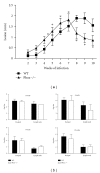Reactive oxygen species and nitric oxide in cutaneous leishmaniasis
- PMID: 22570765
- PMCID: PMC3337613
- DOI: 10.1155/2012/203818
Reactive oxygen species and nitric oxide in cutaneous leishmaniasis
Abstract
Cutaneous leishmaniasis affects millions of people around the world. Several species of Leishmania infect mouse strains, and murine models closely reproduce the cutaneous lesions caused by the parasite in humans. Mouse models have enabled studies on the pathogenesis and effector mechanisms of host resistance to infection. Here, we review the role of nitric oxide (NO), reactive oxygen species (ROS), and peroxynitrite (ONOO(-)) in the control of parasites by macrophages, which are both the host cells and the effector cells. We also discuss the role of neutrophil-derived oxygen and nitrogen reactive species during infection with Leishmania. We emphasize the role of these cells in the outcome of leishmaniasis early after infection, before the adaptive T(h)-cell immune response.
Figures


References
-
- Murray HW, Berman JD, Davies CR, Saravia NG. Advances in leishmaniasis. Lancet. 2005;366(9496):1561–1577. - PubMed
-
- Kedzierski L, Zhu Y, Handman E. Leishmania vaccines: progress and problems. Parasitology. 2006;133(2):S87–S112. - PubMed
-
- Bañuls AL, Hide M, Prugnolle F. Leishmania and the Leishmaniases: a parasite genetic update and advances in taxonomy, epidemiology and pathogenicity in humans. Advances in Parasitology. 2007;64:1–109. - PubMed
-
- Killick-Kendrick R. The life-cycle of Leishmania in the sandfly with special reference to the form infective to the vertebrate host. Annales de Parasitologie Humaine et Comparee. 1990;65(1, supplement 1):37–42. - PubMed
LinkOut - more resources
Full Text Sources

